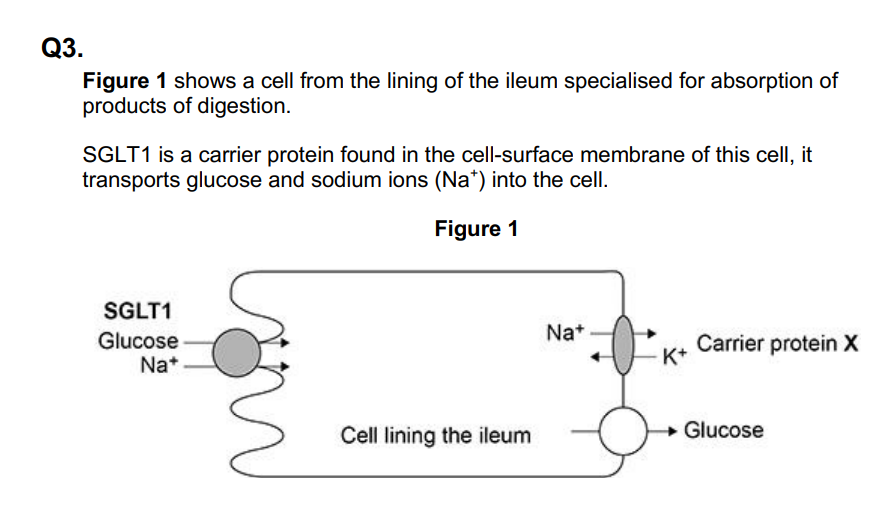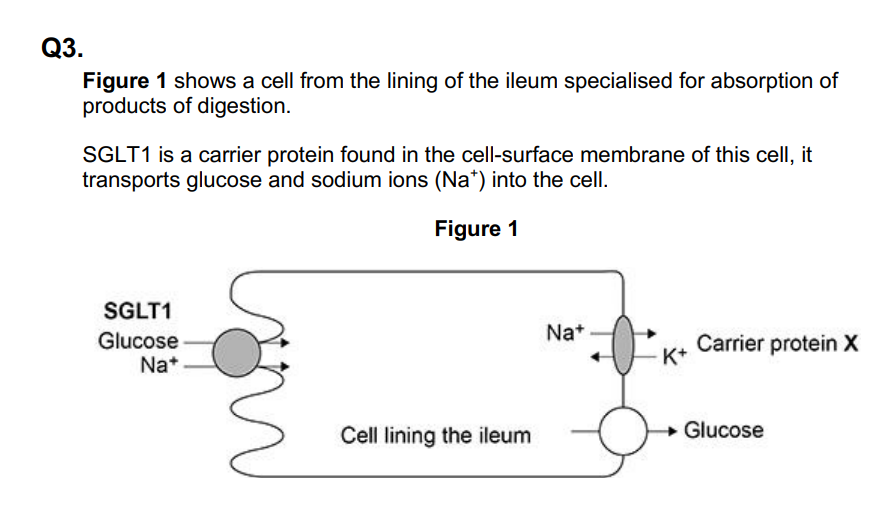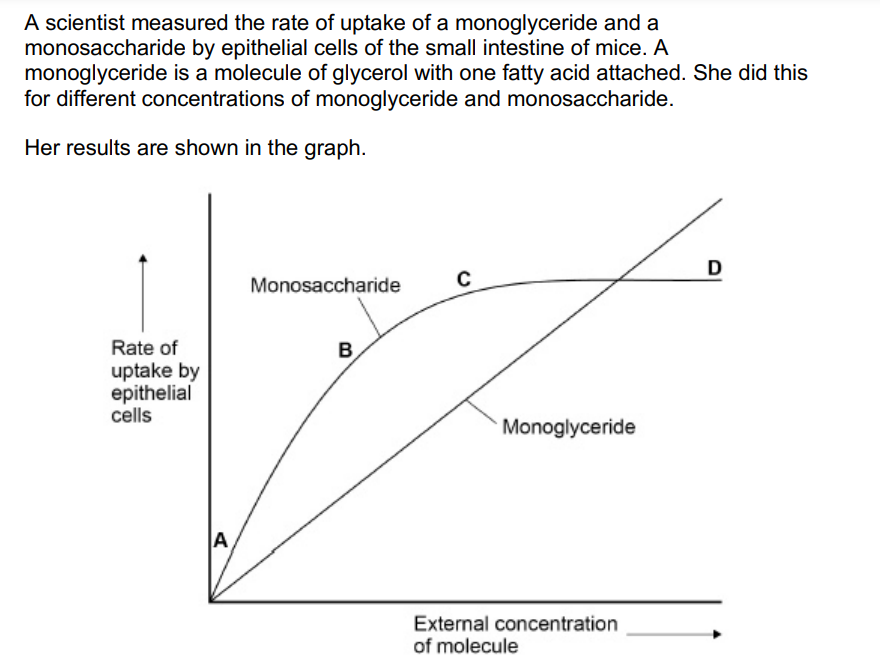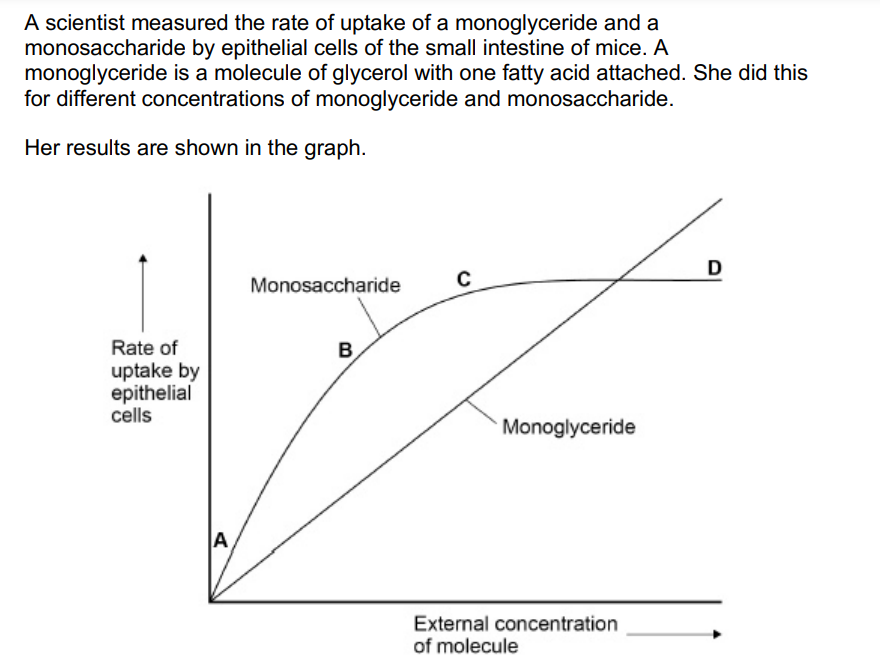EQ: Transport across Cell Membranes
1/13
Earn XP
Description and Tags
Name | Mastery | Learn | Test | Matching | Spaced |
|---|
No study sessions yet.
14 Terms
Name and describe five ways substances can move across the cell-surface membrane into a cell. (5 marks)
Simple diffusion of small/non-polar molecules down a concentration gradient
Facilitated diffusion down a concentration gradient via protein carrier/channel
Osmosis of water down a water potential gradient
Active transport against a concentration gradient via protein carrier using ATP
Co-transport of 2 different substances using a carrier protein

The action of the carrier protein X in Figure 1 is linked to a membrane-bound ATP hydrolase enzyme.
Explain the function of this ATP hydrolase. (2 marks)
(ATP to ADP + Pi ) Releases energy
(energy) allows ions to be moved against a concentration gradient

The movement of Na+ out of a cell allows the absorption of glucose into the cell lining the ileum. Explain how. (2 marks)
Generates diffusion gradient for Na+ (from ileum into cell)
Na+ moving in by co-transport, brings glucose with it
Describe and explain three features you would expect to find in a cell specialised for absorption. (3 marks)
Microvilli so large surface area
Large number of carrier/channel proteins so fast rate (of absorption)
Large number of mitochondria so make (more) ATP (by respiration)
The movement of substances across cell membranes is affected by membrane structure. Describe how. (5 marks)
Phospholipid bilayer allows movement of nonpolar substances
Phospholipid bilayer prevents movement of polar substances
Carrier proteins allow active transport
Channel/carrier proteins allow facilitated diffusion/co-transport
Number of channels/carriers determines how much movement
Membrane surface area determines how much diffusion/movement
Give two similarities in the movement of substances by diffusion and by osmosis. (2 marks)
Movement down a gradient
Passive processes

Use your knowledge of transport across membranes to explain the shape of the curve in the graph for uptake of monosaccharides between concentrations:
A and B
B and C
(3 marks)
Facilitated diffusion between A and B
Rate of uptake proportional to external concentration between C and D
All channel / carrier proteins in use

The graph is evidence for monoglycerides being lipid-soluble molecules. Suggest how. (2 marks)
Rate of uptake is proportional (so diffusion occurring)
Lipid-soluble molecules diffuse through phospholipid bilayer
The cells of beetroot contain a red pigment. A student investigated the effect of temperature on the loss of red pigment from beetroot. He put discs cut from beetroot into tubes containing water. He maintained each tube at a different temperature. After 25 minutes, he measured the percentage of light passing through the water in each tube.
The student put the same volume of water in each tube.
Explain why it was important that he controlled this experimental variable. (2 marks)
If too much water the concentration of pigment (in solution) will be lower than expected
So results (from different temperatures) are comparable
The cells of beetroot contain a red pigment. A student investigated the effect of temperature on the loss of red pigment from beetroot. He put discs cut from beetroot into tubes containing water. He maintained each tube at a different temperature. After 25 minutes, he measured the percentage of light passing through the water in each tube.
Describe a method the student could have used to monitor the temperature of the water in each tube. (1 mark)
(Take) readings (during the experiment) using a (digital) thermometer
In mammals, in the early stages of pregnancy, a developing embryo exchanges substances with its mother via cells in the lining of the uterus. At this stage, there is a high concentration of glycogen in cells lining the uterus.
Suggest and explain two ways the cell-surface membranes of the cells lining the uterus may be adapted to allow rapid transport of nutrients. (2 marks)
Membrane folded so increased surface area (accept microvilli to increase surface area)
Large number of protein channels / carriers (in membrane) for facilitated diffusion
Large number of protein carriers (in membrane) for active transport
Sodium ions from salt (sodium chloride) are absorbed by cells lining the gut. Some of these cells have membranes with a carrier protein called NHE3. NHE3 actively transports one sodium ion into the cell in exchange for one proton (hydrogen ion) out of the cell.
Use your knowledge of transport across cell membranes to suggest how NHE3 does this. (3 marks)
Co-transport
Uses (hydrolysis of) ATP
Sodium ion and proton bind to the protein
Protein changes shape (to move sodium ion and / or proton across the membrane)
High absorption of salt from the diet can result in a higher than normal concentration of salt in the blood plasma entering capillaries. This can lead to a build-up of tissue fluid.
Explain how. (2 marks)
(Higher salt) results in lower water potential of tissue fluid
(So) less water returns to capillary by osmosis (at venule end)
Water and inorganic ions have important biological functions within cells.
Compare and contrast the processes by which water and inorganic ions enter cells. (3 marks)
Comparison: both move down concentration gradient
Comparison: both move through (protein) channels in membrane
Contrast: ions can move against a concentration gradient by active transport